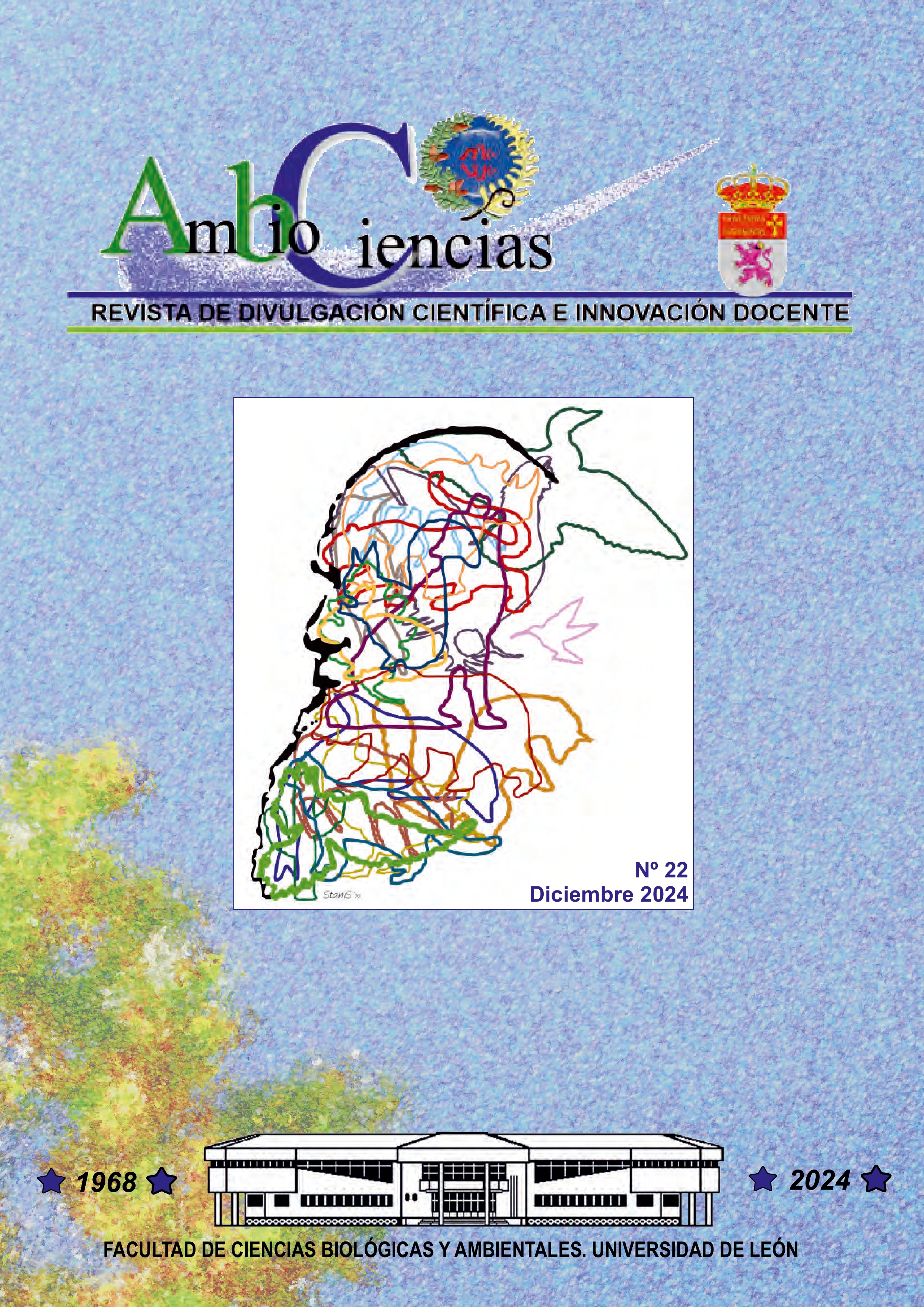Selección de hábitat
compendio de las causas del movimiento animal
DOI:
https://doi.org/10.18002/ambioc.i22.8623Palabras clave:
comportamiento animal, conservación, ecología del movimiento, selección de recursos, telemetría, ZoologíaResumen
El movimiento de los animales determina la eficacia biológica de los individuos, y la composición de poblaciones, comunidades y ecosistemas, condicionando también fenómenos como la transmisión de enfermedades y parásitos, la polinización o la dispersión de semillas. Por eso es clave comprender las causas y consecuencias del movimiento animal. Este artículo pretende ser una introducción para quien quiera trabajar en movimiento animal, y, más concretamente, en selección de hábitat. Para ello, he resumido el marco teórico de la ecología del movimiento y sus principales métodos y temáticas de estudio: análisis de trayec- torias, estudio de los patrones de movimiento y las áreas de campeo y selección de hábitat. A continuación, explico el marco teórico de la selección de hábitat, ilustrando los principales métodos de estudio con algunos estudios de caso específicos sobre reptiles y mamíferos. Al final, discuto las principales
ventajas decada método de estudio en selección de hábitat.
Descargas
Citas
Acero-Murcia, A. C., Almario-Vaquiro, L., Ortega, Z., Garcia, J., Camacho, R. L. y Defler, T. 2024. Seasonal behavioral patterns of the Caqueta titi monkey (Plecturocebus caquetensis). bioRxiv. 2024.01.10.573946. Disponible en: https://www.biorxiv. org/content/10.1101/2024.01.10.573946v1.full
Avgar, T., Potts, J. R., Lewis, M. A. y Boyce, M. S. 2016. Integrated step selection analysis: bridging the gap between resource selection and animal movement. Meth- ods in Ecology and Evolution, 7(5):619-630.
Benício, R. A., Passos, D. C., Mencía, A. y Ortega, Z. 2021. Microhabitat selection of the poorly known lizard Tropidurus lagunablanca (Squamata: Tropiduridae) in the Pantanal, Brazil. Papéis Avulsos de Zoologia, 61:p.e20216118.
Börger, L., Dalziel, B. D. y Fryxell, J. M. 2008. Are there general mechanisms of animal home range behaviour? A review and prospects for future research. Ecology Letters, 11(6):637-650.
Boyce, M. S. y McDonald, L. L. 1999. Relating populations to habitats using resource selection functions. Trends in Ecology & Evolution, 14(7):268-272.
Bunnefeld, N., Börger, L., van Moorter, B., Rolandsen, C. M., Dettki, H., Solberg, E. J. y Ericsson, G. 2011. A model‐driven approach to quantify migration patterns: individual, regional and yearly differences. Journal of Animal Ecology, 80(2):466- 476.
Burt, W. H. 1943. Territoriality and home range concepts as applied to mammals. Journal of Mammalogy, 24(3):346-352.
Carvalho, A. L. G. 2016. Three new species of the Tropidurus spinulosus group (Squamata: Tropiduridae) from eastern Paraguay. American Museum Novitates, 2016(3853):1-44.
Conners, M. G., Michelot, T., Heywood, E. I., Orben, R. A., Phillips, R. A., Vyssotski, A. L., Shaffer, S. A. y Thorne, L. H. 2021. Hidden Markov models identify major movement modes in accelerometer and magnetometer data from four albatross species. Movement Ecology, 9:1-16.
DeCesare, N. J., Hebblewhite, M., Schmiegelow, F., Hervieux, D., McDermid, G. J., Neufeld, L., Bradley, M., Whittington, J., Smith, K. G., Morgantini, L. E. y Wheatley, M. 2012. Transcending scale dependence in identifying habitat with resource selection functions. Ecological Applications, 22(4):1068-1083.
Duchesne, T., Fortin, D. y Courbin, N., 2010. Mixed conditional logistic regression for habitat selection studies. Journal of Animal Ecology, 79(3):548-555.
Fleming, C. H., Fagan, W. F., Mueller, T., Olson, K. A., Leimgruber, P. y Calabrese, J. M. 2015. Rigorous home range estimation with movement data: a new autocorrelated kernel density estimator. Ecology, 96(5):1182-1188.
Fryxell, J. M., Hazell, M., Börger, L., Dalziel, B. D., Haydon, D. T., Morales, J. M., McIntosh, T. y Rosatte, R. C. 2008. Multiple movement modes by large herbivores at multiple spatiotemporal scales. Proceedings of the National Academy of Scienc- es, 105(49):19114-19119.
Giroux, A., Ortega, Z., Attias, N., Desbiez, A. L. J., Valle, D., Börger, L., y Oliveira-Santos,
L. G. R., 2023. Activity modulation and selection for forests help giant anteaters to cope with temperature changes. Animal Behaviour, 201:191-209.
Giroux, A., Ortega, Z., Bertassoni, A., Desbiez, A. L. J., Kluyber, D., Massocato, G. F., De Miranda, G., Mourao, G., Surita, L., Attias, N. y Bianchi, R. D. C. 2022. The role of environmental temperature on movement patterns of giant anteaters. Inte- grative Zoology, 17(2):285-296.
Giroux, A., Ortega, Z., Oliveira-Santos, L. G. R., Attias, N., Bertassoni, A. y Desbiez, A. L. J. 2021. Sexual, allometric and forest cover effects on giant anteaters’ movement ecology. PLOS ONE, e0253345.
Glennie, R., Adam, T., Leos‐Barajas, V., Michelot, T., Photopoulou, T. y McClintock, B. T. 2023. Hidden Markov models: Pitfalls and opportunities in ecology. Methods in Ecology and Evolution, 14(1):43-56.
Guerra, A., de Oliveira Roque, F., Garcia, L. C., Ochoa-Quintero, J. M., de Oliveira, P. T. S., Guariento, R. D. y Rosa, I. M. 2020. Drivers and projections of vegetation loss in the Pantanal and surrounding ecosystems. Land Use Policy, 91:104388.
Hertz, P. E., Huey, R. B. y Stevenson, R. D. 1993. Evaluating temperature regulation by field-active ectotherms: the fallacy of the inappropriate question. The American Naturalist, 142(5):796-818.
Hooten, M. B., Johnson, D. S., McClintock, B. T. y Morales, J. M. 2017. Animal Movement: Statistical Models for Telemetry Data. CRC Press, Florida, Estados Unidos.
IPCC. 2021. Summary for policymakers. En: V. Masson Delmotte, P. Zhai, A. et al. (Eds.), Contribution of working group I to the sixth assessment report of the intergov- ernmental panel on climate change. Climate change 2021: The physical science basis (pp. 3-32). Cambridge University Press. Cambridge, Reino Unido.
Jeltsch, F., Bonte, D., Pe’er, G., Reineking, B., Leimgruber, P. et al. 2013. Integrating movement ecology with biodiversity research-exploring new avenues to address spatiotemporal biodiversity dynamics. Movement Ecology, 1(1):6.
Johnson, D. H. 1980. The comparison of usage and availability measurements for evaluating resource preference. Ecology, 61(1):65-71.
Katzner, T. E. y Arlettaz, R. 2020. Evaluating contributions of recent tracking-based animal movement ecology to conservation management. Frontiers in Ecology and Evolution, 7:519.
Kays, R., Crofoot, M. C., Jetz, W. y Wikelski, M. 2015. Terrestrial animal tracking as an eye on life and planet. Science, 348(6240):p.aaa2478.
Langrock, R., King, R., Matthiopoulos, J., Thomas, L., Fortin, D. y Morales, J. M. 2012. Flexible and practical modeling of animal telemetry data: hidden Markov mod- els and extensions. Ecology, 93(11):2336-2342.
Lefcheck, J. S. 2016. piecewiseSEM: Piecewise structural equation modelling in R for ecology, evolution, and systematics. Methods in Ecology and Evolution, 7(5):573-579.
Leos-Barajas, V., Gangloff, E. J., Adam, T., Langrock, R., Van Beest, F. M., Nabe-Nielsen, J. y Morales, J. M. 2017. Multi-scale modeling of animal movement and general behavior data using hidden Markov models with hierarchical structures. Journal of Agricultural, Biological and Environmental Statistics, 22:232-248.
Liedke, A. M., Bonaldo, R. M., Segal, B., Ferreira, C. E., Nunes, L. T., Burigo, A. P., Buck, S., Oliveira-Santos, L. G. R. y Floeter, S. R. 2018. Resource partitioning by two syntopic sister species of butterflyfish (Chaetodontidae). Journal of the Marine Biological Association of the United Kingdom, 98(7):1767-1773.
Manly, B. F. L., McDonald, L., Thomas, D. L., McDonald, T. L. y Erickson, W. P. 2002. Resource selection by animals: statistical design and analysis for field studies. Kluwer Academic Publishers, Londres, Reino Unido.
Marques, J. F., Alves, M. B., Silveira, C. F., Silva, A. A. E., Silva, T. A., Dos Santos, V. J. y Calijuri, M. L. 2021. Fires dynamics in the Pantanal: Impacts of anthropo- genic activities and climate change. Journal of Environmental Management, 299:p.113586.
Morales, J. M., Haydon, D. T., Frair, J., Holsinger, K. E. y Fryxell, J. M. 2004. Extracting more out of relocation data: building movement models as mixtures of random walks. Ecology, 85(9):2436-2445.
Nathan, R., Monk, C. T., Arlinghaus, R., Adam, T., Alós, J., Assaf, M., Baktoft, H., Beard- sworth, C. E., Bertram, M. G., Bijleveld, A .I. y Brodin, T. 2022. Big-data approaches lead to an increased understanding of the ecology of animal move- ment. Science, 375(6582):p.eabg1780.
Ortega, Z., Mencía, A., Martins, K., Soares, P., Ferreira, V. L. y Oliveira-Santos, L. G. 2019. Disentangling the role of heat sources on microhabitat selection of two Neotropical lizard species. Journal of Tropical Ecology, 35(4):149-156.
Shipley, B. 2016. Cause and correlation in biology: A user’s guide to path analysis, structural equations and causal inference with R. Cambridge University Press. Cam- bridge, Reino Unido.
Thurfjell, H., Ciuti, S., y Boyce, M. S. 2014. Applications of step-selection functions in ecology and conservation. Movement Ecology, 2:1-12.
Tollefson, J. 2018. Deforestation ticks up in Brazil’s savannah. Nature, 12 July. https://www.nature.com/articles/d41586-018-05695-9
Tomas, W. M., Andrade, M. H., Berlinck, C. N., Bolzan, F., Camilo, A. R. et al. 2024. Eight basic principles for the elaboration of public policies and development projects for the Pantanal. Conservation Science and Practice, e13207.
Tomas, W. M., Berlinck, C. N., Chiaravalloti, R. M., Faggioni, G. P., Strüssmann, C. et al. 2021. Distance sampling surveys reveal 17 million vertebrates directly killed by the 2020’s wildfires in the Pantanal, Brazil. Scientific Reports, 11(1):23547.
Turchin, P. 1998. Quantitative Analysis of Movement. Sinauer Associates, Sunderland, Massachusetts, Estados Unidos.
Vickers, M., Manicom, C. y Schwarzkopf, L. 2011. Extending the cost-benefit model of thermoregulation: high-temperature environments. The American Naturalist, 177(4):452-461.
Williams, H. J., Taylor, L. A., Benhamou, S., Bijleveld, A. I., Clay, T. A. et al. 2020. Opti- mizing the use of biologgers for movement ecology research. Journal of Animal Ecology, 89(1):186-206.
Descargas
Publicado
Cómo citar
Número
Sección
Licencia

Esta obra está bajo una licencia internacional Creative Commons Atribución-NoComercial-CompartirIgual 4.0.
Los autores que publican en esta revista están de acuerdo con los siguientes términos:
- Los autores ceden de forma no exclusiva los derechos de explotación (reproducción, distribución, comunicación pública, transformación) a la Universidad de León, por lo que pueden establecer, por separado, acuerdos adicionales para la distribución no exclusiva de la versión de la obra publicada en la revista (por ejemplo, alojarlo en un repositorio institucional o publicarlo en un libro), con un reconocimiento de su publicación inicial en esta revista.
- Este trabajo se encuentra bajo la Creative Commons Attribution-NonCommercial-ShareAlike 4.0 International License. Puede consultarse desde aquí la versión informativa y el texto legal de la licencia.
- Se permite y se anima a los autores a difundir electrónicamente las versiones pre-print (versión antes de ser evaluada) y/o post-print (versión evaluada y aceptada para su publicación) de sus obras antes de su publicación, ya que favorece su circulación y difusión más temprana y con ello un posible aumento en su citación y alcance entre la comunidad académica.







